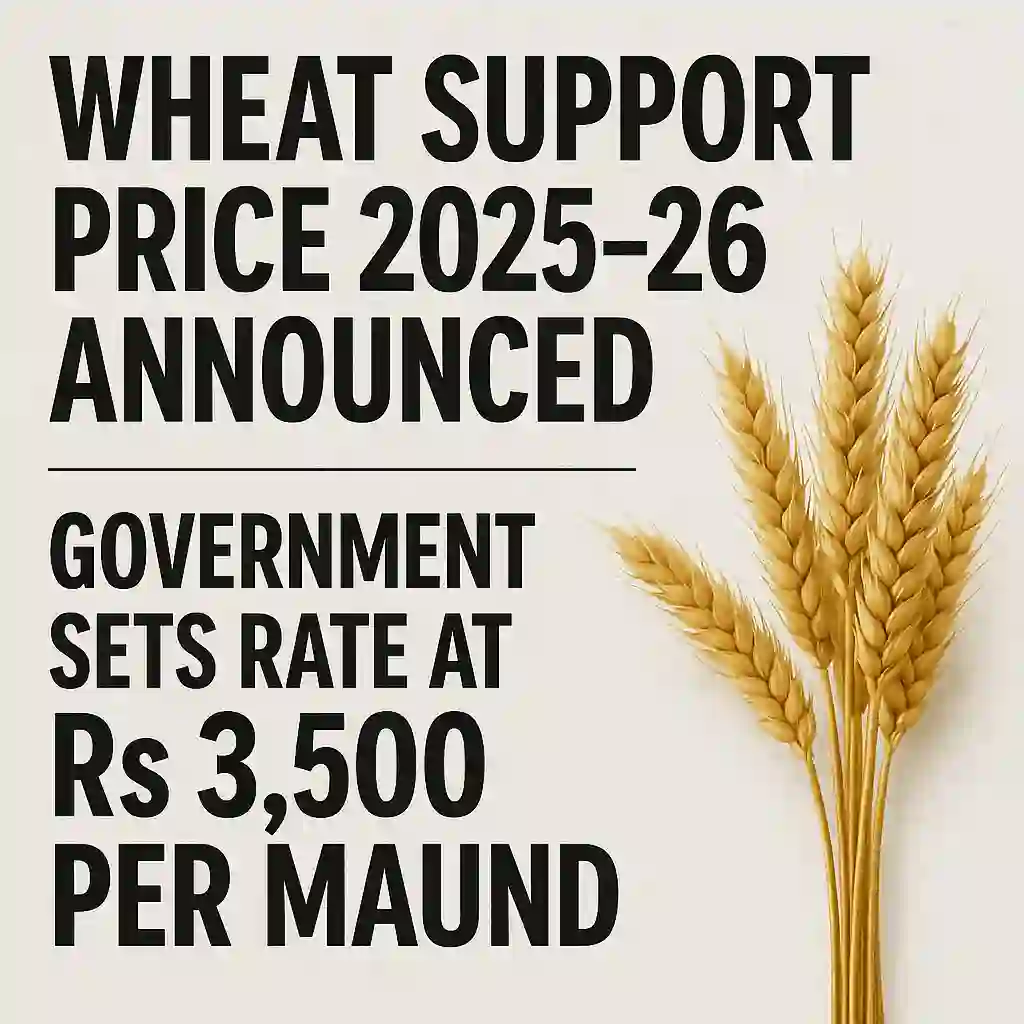Wheat Support Price 2025–26 Announced: Government Sets Rate at Rs 3,500 per Maund
The Wheat Support Price 2025–26 Announced has officially announced the Wheat Support Price for the 2025–26 season at Rs 3,500 per maund (40kg). This decision comes at a crucial time when farmers are struggling with rising diesel prices, fertilizer costs, and higher labour charges, making wheat cultivation increasingly expensive. The new rate aims to protect farmers from losses and ensure that wheat production remains sustainable for the next harvest season.
Every year, the government sets a minimum support price (MSP) to purchase wheat directly from farmers through procurement centers operated by PASSCO and provincial food departments. This price acts as a guaranteed market rate, preventing middlemen from exploiting small farmers. With Rs 3,500 per maund, the government hopes to encourage more wheat plantation, reduce dependence on imports, and secure the country’s national food security.
However, while the decision has been welcomed by farming communities, it has also sparked concerns among flour mill associations and consumers, as the increase in support price is likely to push up the retail prices of flour, roti, and naan. Analysts believe that naan could soon cost Rs 30–40 and 20kg flour bags may exceed Rs 2,800–3,000 in many provinces.
Despite mixed reactions, policymakers argue that supporting farmers is essential to avoid future wheat shortages and costly imports, which burden the national treasury. The 2025–26 support price is being viewed as an investment in agricultural stability and a strategic move towards self-sufficiency.
Wheat Support Price in Pakistan – Yearly Comparison
| Year | Support Price (Rs per Maund) |
|---|---|
| 2021–22 | 1,800 |
| 2022–23 | 2,200 |
| 2023–24 | 3,000 |
| 2024–25 | 3,900 (Provincial Variation) |
| 2025–26 | 3,500 (Federal Rate) |
Why Did the Government Fix Wheat Price at Rs 3,500?
The Rs 3,500 support price was finalized after consultations with agricultural bodies, provincial governments, and economic experts. The decision is based on:
- Rising input costs – Urea touched Rs 5,000 per bag, diesel is over Rs 300 per litre.
- Farmer protests demanding relief against inflation.
- To prevent wheat smuggling and hoarding by stabilizing local prices.
- To reduce dependence on imported wheat, which drains foreign reserves.
- To ensure wheat cultivation remains profitable, encouraging larger plantation areas.
Check Also: Punjab Gold Rate Today – Latest 24K & 22K Prices in All Major Cities of Punjab 2025
Impact on Farmers, Flour Mills & Consumers
| Stakeholder | Effect of Rs 3,500 Support Price |
|---|---|
| Farmers | Positive – Higher profit and motivation for more sowing. |
| Flour Mills | Negative – Higher procurement cost, reducing profit margins. |
| Retailers | Slightly Higher Flour Prices Expected. |
| Consumers | Mixed – Food inflation risk, but long-term food stability. |
Expected Flour & Roti Prices in 2025–26
| Item | Current Price | Expected Price After Support Rate |
|---|---|---|
| 20kg Flour Bag | Rs 2,600–2,800 | Rs 2,800–3,200 |
| Roti | Rs 20–25 | Rs 30–35 |
| Naan | Rs 25–30 | Rs 35–40 |
Government Procurement & PASSCO Strategy
The government will purchase wheat through:
- PASSCO (Pakistan Agricultural Storage & Services Corporation)
- Punjab Food Department
- Sindh Food Department
- KP and Balochistan Procurement Centers
The procurement target for 2025–26 is expected to be 4–5 million tons to maintain strategic reserves and supply subsidized flour to the public.
Read More: Today Gold Rate in Pakistan Per Tola – Latest 24K & 22K Prices Updated Daily (October 2025)
Comparison with International Wheat Prices
Currently, the global wheat price ranges between $250 to $300 per ton, according to international commodity market data. When converted to Pakistani currency, this equals approximately Rs 4,000 to 4,800 per maund, which is significantly higher than the newly announced local support price of Rs 3,500 per maund. This clearly shows that Pakistan’s MSP is still competitive compared to global rates. Therefore, it is far more economical for the government to encourage domestic procurement rather than relying on expensive wheat imports, which not only strain foreign exchange reserves but also cause delays in supply chain logistics.
Will Wheat Imports Still Be Required?
Experts suggest that if the government ensures strict procurement and prevents smuggling, Pakistan may not need large-scale imports. However, delays in procurement and poor storage policies could force expensive wheat imports later in 2026.
Future Outlook: Wheat Price Trend for 2026–27
Agriculture analysts predict that wheat support price may touch Rs 4,000–4,200 per maund in 2026–27, depending on global trends, inflation, and fertilizer price movement.
Read Also: Pakistani-Origin Boxer Makes History in New York – Knocks Out American Fighter in Viral Match
FAQs Wheat Support Price 2025–26 Announced:
1. What is the official wheat support price for 2025–26 in Pakistan?
The Government of Pakistan has fixed the wheat support price at Rs 3,500 per maund (40kg) for the 2025–26 crop season.
2. Is the Rs 3,500 support price applicable across all provinces?
Yes, this is a federal support price, applicable in Punjab, Sindh, Khyber Pakhtunkhwa, and Balochistan, unless provinces issue separate notifications.
3. When will the government start wheat procurement at this rate?
Procurement will begin in March–April 2025, immediately after the wheat harvest season.
4. Who will buy wheat from farmers at the support price?
PASSCO and Provincial Food Departments will purchase wheat directly from farmers through official procurement centers.
5. Will flour prices increase after the new support price announcement?
Yes, 20kg flour bags may increase by Rs 200–300, and naan/roti prices may rise to Rs 30–40.
6. How does this support price benefit farmers?
It ensures a guaranteed minimum income, protects farmers from middlemen exploitation, and encourages more wheat cultivation.
7. Can private buyers offer less than Rs 3,500 per maund?
Legally, they should match the government rate, but some private buyers may offer lower prices if procurement centers delay purchases.
8. What was the wheat support price last year (2024–25)?
Punjab had set Rs 3,900, while Sindh announced Rs 4,000 per maund in 2024–25.
9. Will the government provide subsidized flour to the public after this increase?
Yes, Utility Stores and Ehsaas/Benazir subsidy programs are expected to continue providing discounted flour to low-income families.
10. Will Pakistan still need to import wheat in 2025–26?
If domestic procurement is efficiently managed, imports may not be necessary, but mismanagement could still force wheat imports later in the year.
Final Conclusion:
The Wheat Support Price 2025–26 Announced reflects the government’s attempt to balance farmer profitability with consumer affordability. While it boosts confidence among wheat growers, it also raises inflation concerns for the urban population.
However, without proper procurement and storage, support price alone will not solve Pakistan’s chronic wheat crisis. The government must ensure timely procurement, prevent smuggling, crack down on hoarding, and provide targeted flour subsidies to poor households.
If implemented efficiently, the 2025–26 support price policy could stabilize the market, increase wheat production, and reduce reliance on costly imports. But if mismanaged, Pakistan may once again face flour shortages and panic buying.







